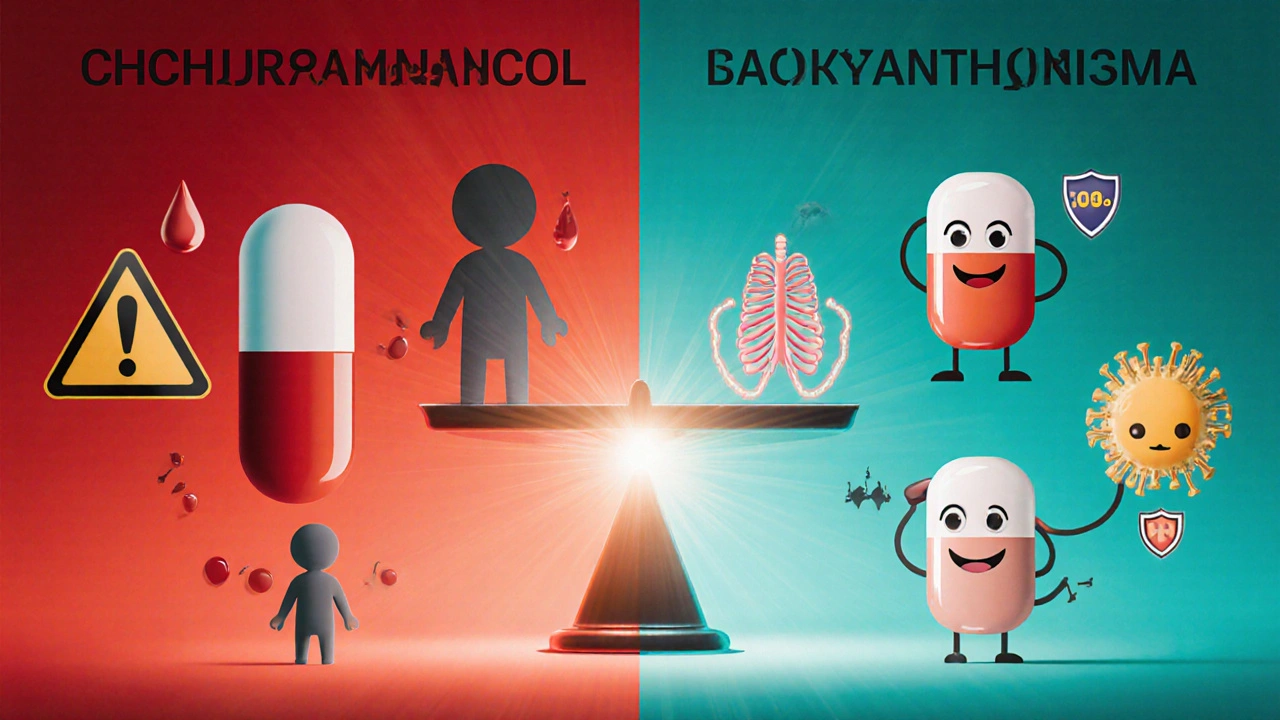Antibiotic Selection Guide
Select Your Clinical Scenario
This tool helps determine if chloramphenicol is appropriate for your case based on clinical guidelines.
Recommendation
Key Takeaways
- Chloramphenicol is a broad‑spectrum antibiotic useful for severe infections but carries notable toxicity.
- Safer oral options such as amoxicillin or azithromycin cover most common bacterial infections.
- When a patient cannot tolerate first‑line drugs, doxycycline or clindamycin often serve as reliable back‑ups.
- Choosing the right drug hinges on infection type, resistance patterns, patient age, and organ function.
- Always weigh the benefits against rare but serious side effects like aplastic anemia.
What Is Chloramphenicol?
chloramphenicol is a synthetic, bacteriostatic antibiotic that works by binding to the 50S ribosomal subunit, halting protein synthesis in a wide range of Gram‑positive and Gram‑negative bacteria. First approved in the 1940s, it quickly became a go‑to for meningitis, typhoid fever, and eye infections. However, its use has dwindled because of a rare but deadly adverse reaction-aplastic anemia-that can occur even after short courses.
When Do Doctors Still Prescribe Chloramphenicol?
Today, clinicians reserve it for three main scenarios:
- Severe infections where first‑line agents fail or resistance is documented.
- Patients allergic to beta‑lactams and macrolides.
- Specific infections like rickettsial diseases in regions lacking safer alternatives.
Because the drug is metabolized mainly by the liver and excreted unchanged in the urine, dose adjustments are needed for hepatic or renal impairment.
Major Drawbacks of Chloramphenicol
Aside from the famous risk of aplastic anemia (< 0.1% incidence), other concerns include:
- Grey‑baby syndrome in neonates due to immature liver enzymes.
- Bone marrow suppression leading to thrombocytopenia.
- Potential drug interactions with anticoagulants and anticonvulsants.
Given these hazards, most guidelines (WHO, FDA) recommend limiting its use to cases where no safer drug is available.

Common Alternatives
Below are the most frequently used substitutes, each with a brief profile.
Amoxicillin
A beta‑lactam penicillin, amoxicillin covers many respiratory tract infections, otitis media, and urinary tract infections. It’s well tolerated, inexpensive, and has a low risk of severe side effects. Resistance can be an issue with beta‑lactamase‑producing organisms, but combining it with clavulanic acid solves most problems.
Cephalexin
Cephalexin belongs to the first‑generation cephalosporins. It offers broader Gram‑positive coverage than amoxicillin and is a solid choice for skin and soft‑tissue infections. Cross‑reactivity with penicillin allergies is low (<10%).
Azithromycin
A macrolide with a long half‑life, azithromycin is prized for its convenient once‑daily dosing and activity against atypical pathogens such as Mycoplasma and Chlamydia. It’s also useful for patients who cannot tolerate beta‑lactams.
Doxycycline
Doxycycline is a tetracycline that penetrates tissues well, making it ideal for Lyme disease, rickettsial infections, and certain acne cases. Side effects are mainly gastrointestinal and photosensitivity, which are generally manageable.
Clindamycin
Clindamycin provides excellent coverage of anaerobes and certain Gram‑positive cocci. It’s often used for serious skin infections or intra‑abdominal infections when beta‑lactams are unsuitable. The main drawback is a higher risk of Clostridioides difficile colitis.
Fluoroquinolones (e.g., Ciprofloxacin)
Fluoroquinolones have broad Gram‑negative activity and good oral bioavailability. They’re reserved for complicated urinary tract infections and certain respiratory infections. Their use is limited by concerns about tendon rupture, QT prolongation, and emerging resistance.
Side‑by‑Side Comparison
| Attribute | Chloramphenicol | Amoxicillin | Azithromycin | Doxycycline | Clindamycin |
|---|---|---|---|---|---|
| Spectrum | Broad (Gram‑+, Gram‑‑) | Gram‑+, some Gram‑‑ | Gram‑+, atypicals | Gram‑+, intracellular | Gram‑+, anaerobes |
| Typical Use | Severe systemic infections | Respiratory, otitis, UTI | STIs, atypicals | Rickettsial, Lyme | Skin, intra‑abdominal |
| Administration | IV or oral | Oral | Oral (once daily) | Oral (twice daily) | IV or oral |
| Major Toxicity | Aplastic anemia, grey‑baby | Allergic rash | GI upset, QT prolongation | Photosensitivity, GI | C. difficile colitis |
| Cost (US$) | ~$30‑$50 per 500 mg tablet | ~$0.10 per tablet | ~$0.20 per tablet | ~$0.15 per tablet | ~$0.25 per tablet |
How to Decide Which Antibiotic Fits Your Situation
Use the following decision tree as a quick reference:
- Identify the suspected pathogen (culture, PCR, local resistance patterns).
- Check for patient allergies (penicillin, macrolide, tetracycline).
- If the infection is life‑threatening and no safe oral option exists, consider Chloramphenicol only after consulting a specialist.
- For community‑acquired pneumonia, start with amoxicillin (or amoxicillin‑clavulanate if beta‑lactamase risk is high).
- For atypical pneumonia or sexually transmitted infections, azithromycin is first‑line.
- For rickettsial diseases or Lyme, doxycycline is preferred.
- If anaerobic coverage is essential (e.g., necrotizing fasciitis), clindamycin or a carbapenem is appropriate.
Always confirm the final choice with local antimicrobial stewardship guidelines.

Monitoring and Safety Tips
Regardless of the drug you pick, regular monitoring can catch problems early:
- Complete blood count weekly for chloramphenicol or clindamycin (watch for bone‑marrow suppression).
- Liver function tests if using doxycycline or fluoroquinolones for >2 weeks.
- Assess for rash or gastrointestinal upset within 48 hours of starting therapy.
- Educate patients on signs of serious adverse events-unexplained bruising, persistent fever, or severe abdominal pain.
Frequently Asked Questions
Is chloramphenicol still used in modern medicine?
Yes, but only for severe infections where safer antibiotics are ineffective or contraindicated, and typically under specialist supervision.
Can I take chloramphenicol with other medications?
It can interact with anticoagulants, anticonvulsants, and some HIV drugs. Always review your full medication list with your doctor.
Why is chloramphenicol dangerous for newborns?
Infants lack the liver enzymes needed to break down the drug, leading to a condition called “grey‑baby syndrome,” which can cause cardiovascular collapse.
When should I choose amoxicillin over azithromycin?
If the infection is caused by typical bacteria (e.g., Streptococcus pneumoniae) and there’s no penicillin allergy, amoxicillin is preferred because it’s cheaper and has a narrower spectrum, reducing resistance pressure.
What are the signs of aplastic anemia from chloramphenicol?
Unexplained fatigue, easy bruising, prolonged bleeding from cuts, or sudden drop in blood counts on lab tests. Immediate medical attention is required.
Bottom Line
Chloramphenicol remains a potent weapon in the antibiotic arsenal, but its toxicity forces clinicians to reserve it for truly exceptional cases. For most everyday infections, gentler agents like amoxicillin, azithromycin, doxycycline, or clindamycin provide comparable efficacy with far lower risk.
By matching the drug’s spectrum, safety profile, and dosing convenience to the patient’s specific needs, you can avoid unnecessary exposure to serious side effects while still treating the infection effectively.









Write a comment
Your email address will be restricted to us